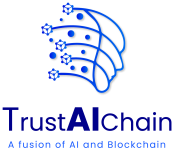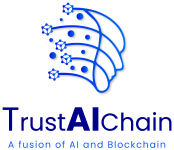This blog delves into how AI and Blockchain technologies can transform global learning communities by addressing significant challenges, enhancing collaboration, improving security, and ensuring equitable access to education.

- AI in Global Learning Communities: Personalized and Scalable Collaboration
Artificial Intelligence is already transforming industries, and its potential in education is becoming more evident as schools, universities, and eLearning platforms begin to harness its power. AI significantly fosters collaboration in global learning communities, particularly by offering personalized learning experiences, enhancing communication, and automating administrative tasks.
- Personalized Learning Experiences
AI excels at personalization by analyzing vast data and adapting learning environments to individual student needs. For instance, AI-powered eLearning platforms can analyze student behavior, preferences, and performance to offer tailored content, recommend resources, or adjust the pace of learning. This level of personalization enables global learners to collaborate more effectively, as AI-driven systems ensure that each participant is working on material best suited to their current skill level and learning objectives.
This individualized approach fosters collaboration in a global setting, where students from diverse backgrounds learn together. By providing personalized support and recommendations, AI helps learners feel confident and supported, making them more likely to engage in discussions, group projects, and collaborative learning activities.
- Breaking Language Barriers
One of the most significant challenges in global learning communities is language diversity. AI can help bridge this gap by providing real-time translation services and language support tools. With AI-powered natural language processing (NLP) algorithms, students can communicate more easily across languages, participating in discussions and collaborative projects without the friction caused by language barriers.
For example, tools like Google Translate or Microsoft Translator are already integrated into various educational platforms to enable smooth communication between students and educators, regardless of their native languages. In the future, more advanced AI models could offer real-time transcription and translation during video calls, facilitating global collaboration in a more immersive and natural way.
- Enhancing Peer Collaboration through AI-Powered Tools
AI-driven platforms can encourage peer collaboration by organizing students into groups based on their skill levels, learning styles, or interests. AI can analyze student data in a global learning environment to form diverse groups where participants can share perspectives and work together on projects. AI can also assist in mediating and resolving conflicts within groups by tracking communication patterns and detecting areas where miscommunication may arise.
Moreover, AI-powered chatbots and virtual assistants can be intermediaries, helping students find study partners, collaborators, or mentors worldwide. These AI tools facilitate smooth communication and collaboration by suggesting relevant discussion topics, answering questions, and connecting students with peers with similar academic goals or interests.

- Blockchain: A Secure and Transparent Foundation for Global Learning
While AI focuses on improving learning experiences and collaboration, Blockchain ensures these global learning communities are secure, transparent, and reliable. Blockchain technology offers decentralized, tamper-proof solutions for managing data, which is especially beneficial in educational systems that involve multiple stakeholders, such as students, teachers, institutions, and accrediting bodies.
- Ensuring Data Security and Privacy
One of the significant concerns in global education is data security and privacy. Students share sensitive personal information with educational institutions and platforms, including academic records, financial details, and identity documents. These records are often centralized, making them vulnerable to cyber-attacks and data breaches. Blockchain can address this issue by decentralizing and encrypting educational data, ensuring that sensitive information is securely stored and only accessible to authorized parties.
In global learning communities, where participants come from various regions with differing regulations on data privacy, Blockchain provides a unified solution. Blockchain’s decentralized nature allows students to maintain control over their data, granting access only to those institutions or individuals who need it. This is particularly useful in collaborative projects where students must share their academic records or credentials with other institutions or potential employers.
- Transparent Credentialing and Academic Records
Blockchain technology can also play a critical role in academic credentialing and the verification of qualifications. Traditionally, centralized institutions issue academic records and certifications, and verifying these records can be time-consuming and prone to fraud. With Blockchain, educational credentials can be securely stored on a decentralized ledger, allowing for instant verification by employers or other institutions. This is particularly beneficial for students and professionals in global learning communities who may need to prove their qualifications across borders.
For instance, a student completing a global eLearning program could have their certifications and academic achievements stored on a Blockchain, accessible to universities or employers worldwide. This seamless verification process saves time and builds trust among global institutions and students, enhancing collaboration in higher education and international career opportunities.
- Facilitating Micro-Credentials and Lifelong Learning
Global learning communities are increasingly embracing the concept of lifelong learning and micro-credentials—short, specialized courses that offer learners the opportunity to gain new skills or knowledge in a particular area. Blockchain can be used to issue and manage these micro-credentials, ensuring that they are secure, verifiable, and widely recognized.
Students in a global learning community may participate in courses offered by multiple institutions or eLearning platforms, and Blockchain can serve as a unifying record of their learning journey. These micro-credentials can be easily shared with potential employers or academic institutions, encouraging collaboration and career mobility in a globally connected world.

- The Synergy of AI and Blockchain in eLearning
When AI and Blockchain are combined, they create a powerful synergy that can address many of the challenges faced by global learning communities. By leveraging AI’s ability to personalize and enhance learning experiences with Blockchain’s security and transparency, educators and learners can collaborate more effectively across borders and institutions.
- AI-Driven Credentialing on Blockchain
One potential application of AI and Blockchain in global learning communities is AI-driven credentialing on Blockchain. AI algorithms can assess student performance and automatically issue credentials based on predefined criteria. These credentials can then be stored on a Blockchain, ensuring that they are secure, verifiable, and accessible to anyone who needs them. This automated system reduces the administrative burden on institutions and allows students to receive recognition for their achievements in real-time.
In a global learning community, this system can help standardize the issuance and recognition of credentials, making it easier for students to collaborate across different institutions and geographical regions. Employers can also trust that these credentials are valid and accurately reflect the skills and knowledge of the individual.
- Smart Contracts for Collaborative Projects
Blockchain’s smart contracts—self-executing contracts with the terms of the agreement directly written into code—can facilitate collaboration by automating agreements between students, institutions, or educational platforms. In a global learning community, smart contracts can be used to manage collaborative projects, ensuring that all participants fulfill their responsibilities and receive the appropriate recognition for their contributions.
For example, a group of students working on an international research project could use a smart contract to distribute tasks, track progress, and ensure that each participant receives credit for their work. The smart contract could automatically trigger rewards or certifications upon project completion, ensuring transparency and fairness in the collaborative process.
- Overcoming Challenges in Global Learning Communities
Despite the potential of AI and Blockchain to enhance collaboration, challenges must be addressed to realize their full benefits in global learning communities.
- Bridging the Digital Divide
The digital divide is one of the primary challenges in implementing AI and Blockchain in global learning communities. Not all students and institutions have access to the necessary technology or internet infrastructure to take full advantage of these innovations. Efforts must be made to ensure these technologies are accessible and affordable for learners in developing regions so that no one is left behind in the shift toward digital education.
- Interoperability and Standardization
For global learning communities to thrive, there must be interoperability and standardization across platforms and institutions. Blockchain and AI technologies must be integrated for seamless collaboration between different systems. This requires the development of international standards for credentialing, data sharing, and collaboration.
- Ethical Considerations and Bias in AI
AI systems are only as good as the data they are trained on, and there is a risk of bias in AI-powered educational tools. Global learning communities must ensure AI algorithms are developed and deployed ethically, focusing on fairness and inclusivity. Institutions must be vigilant in addressing potential biases in AI systems to ensure all students have equal access to opportunities and resources.

Summary
Combining AI and Blockchain technologies offers unprecedented opportunities to enhance collaboration in global learning communities. AI’s ability to personalize learning, break down language barriers, and streamline communication, paired with Blockchain’s secure and transparent data management, creates a foundation for a truly global educational system.
By addressing challenges such as the digital divide, interoperability, and ethical concerns, we can unlock the full potential of AI and Blockchain to create more inclusive, secure, and collaborative learning environments that prepare students for a rapidly evolving world.
As educational institutions and eLearning platforms continue to embrace these technologies, the future of global learning communities looks brighter than ever. The synergy between AI and Blockchain will enhance collaboration and pave the way for a more equitable and connected global education system.








2 Responses
Awesome https://shorturl.at/2breu
Thank you!